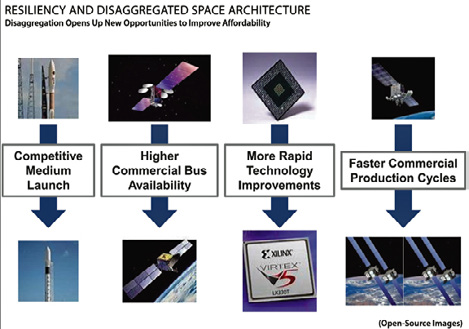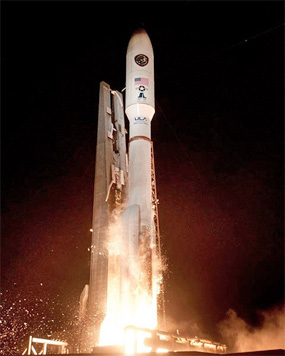Note: This is Part Two of MilsatMagazine’s coverage of Air Force Space Command’s White Paper on “Resiliency and Disaggregated Space Architectures.” Part One provided an overview of the new security environment driving the need for resiliency, and established common definitions for “resiliency” and “disaggregation.” Part One is available within the October issue of MilsatMagazine (http://www.milsatmagazine.com/story.php?number=1915825642).

Attributes Of Disaggregation
Disaggregation is a strategy to affect multiple elements of our overall space architecture. Its purpose is to provide options within architecture to drive down cost, increase resiliency and distribute capability. Disaggregation has other benefits-—systems are allowed to be less complex, easier to maintain and affords the Air Force the ability to lower per-unit production costs and improve industrial base stability. Given program of record acquisition decisions we are facing in pending budget deliberations, the timing is right for reassessment of the historical paradigm of fielding monolithic space systems that result in costly, and vulnerable, space architectures.
Although the primary focus of this article is on disaggregation of the space segment, it is important to note that disaggregation should be considered at an enterprise level, to include connecting nodes, ground systems, command and control, and launch vehicle architecture. System planners should consider all aspects of an architecture, including additional ground entry points, added complexity for mission planning and command and control, and commercial or foreign elements intertwined with the DoD ground segment.
Disaggregation offers significant leverage in keeping pace with advancing technologies and associated benefits in terms of requirements discipline, sustainment of the space industrial base, achieving affordability, and deterring adversary action against U.S. space systems. Each of these opportunities is described below, with considerations for operational impact and costs.
Increased Technology Refresh Opportunities
Current satellite systems have developmental timelines of up to 14 years1. Once on orbit these systems routinely exceed 10 years of life. During development, incorporating advances in technology is often difficult as it slows design development and adds significantly to system costs. Once on orbit, hardware upgrades are not practicable. This combination results in technology being “locked in” for what may be a lengthy period of time.

This is a substantial drawback considering the pace of technology change, rapidly evolving user needs, and constantly changing tactics, techniques and procedures of adversaries. To remain responsive to these demands requires mission flexibility and an adaptable acquisition process. Through less complex satellites employing more flexible designs, disaggregation facilitates the incorporation of new technology before the end of a space constellation’s lifetime. In this regard, it represents an evolution of system acquisition that enables adaptable platforms, software, and capabilities to more effectively match emerging needs.
Improved Requirements Discipline
As discussed, one consequence of our historical approach to space system design is an extended development timeline. Coupled with rapidly advancing technology, these timelines and associated acquisition paradigms may place pressure on program managers and system developers to adapt and incorporate new requirements during the design phase—to make systems exquisite, in other words—adding significantly to their costs2. Disaggregation and the potential to refresh technology, as discussed above, provides an opportunity to enforce stricter requirements discipline with all the associated value in cost and schedule. That is, program managers have increased opportunity to lock in a firm requirements baseline that will not be deviated from, as they know there may be increased opportunity to incorporate system changes later, even after satellites have begun launching. This model of “constant adaptability” is a significant deviation from current acquisition practices, and could improve affordability and resiliency.
Increased Launch + Space Industrial Base Stability
As noted in the most recent National Space Policy, the U.S. space industrial base plays a vital role in providing and sustaining space capabilities and national security. Continuous incorporation of new technology into space systems and higher rates of production will also enable industry to remain on the cutting edge of technology and provide additional business stability and incentives. Higher throughput and more stable production rates should produce a larger market for space-qualified parts, thus providing incentives for more companies to enter the marketplace. Improving stability is an important factor in maintaining critical system expertise and sustaining “one-of-a-kind” manufacturing capabilities.
Disaggregation could also foster healthy competition and assist with distributing workload over multiple contractors. Payloads flown on separate spacecraft groups could be provided by different contractor teams, potentially dividing large contracts, creating industrial competition and allowing technology insertion on independent timelines. While beneficial, this approach would require increased focus on integration efforts, starting with stated requirements, and spanning multiple contract team products.
Depending on the approach to disaggregation employed, it could lead to more frequent and predictable launch profiles. An increased launch rate may smooth episodic launch schedules, providing a more stable workload for the launch industry. Further, increased frequency of launch would allow industry to amortize the significant specialized manpower costs associated with the operation and maintenance of launch capabilities, while helping to sustain individual suppliers whose only customer arises with each individual launch.
Higher production throughput and increased stability may further enable incorporation of commercial best practices3 and competition into national security space architectures when commercial best practices align with system requirements. Commercial best practices in satellite system designs have been shown to minimize the amount of redesign required for different missions, reducing cost and production time.
For example, the commercial satellite bus market has demonstrated the ability to produce satellites in 24 to 36 months and at much lower price points than DoD has been able to achieve4. Less complex systems may also increase the willingness for sponsors to forgo the costly mission assurance associated with current launch vehicles and accept increased risk.
Increased Affordability
The DoD is facing a fiscal environment that requires innovative approaches to deliver required mission capability. Declining budgets will mean fewer resources available for system sustainment, procurement, manpower and operation. These factors, combined with cost escalation in the space domain that far exceeds the Consumer Price Index5 , drives a requirement for systems that are less costly to manufacture, operate and maintain. Smaller, less complex and lighter systems may shorten procurement timelines, save upfront RDT&E investment and reduce risk in technology development.
Combined, these characteristics of disaggregated space architectures may lead to cost savings. Increased production lots would also allow manufacturing production lines to be utilized for longer periods of time at optimized production rates, thus reducing per unit cost and leveling procurement spikes. A good example of this effect is the Global Positioning Satellite system, where larger production numbers provide a more stable manufacturing environment and long-term facility and equipment utilization.

Artistic rendition of the NPOESS satellite.
Previous satellite system acquisition programs have experienced large cost overruns and schedule delays. While root causes vary by program, a common reason for cost increases is the difficulty of integrating multiple payloads onto a single bus. This often proves to be technologically challenging and can significantly delay fielding a system.
In the National Polar-Orbiting Operational Environmental Satellite System (NPOESS) program, complexity associated with integrating multiple, diverse sensors on a single platform grew to be so expensive and difficult to manage that the program was canceled, opening the possibility of a future gap in capability6. Disaggregation reduces this type of integration risk by focusing on less complex designs that may provide singular functions (or components), but operating together provide a capability comparable to the original monolithic design.
Smaller programs of record across the Future Years Defense Program (FYDP) may also provide advantages in program execution, as large, single investment programs are sometimes needed to act as “bill payers” in times of budget decline. Less costly programs can smooth erratic spikes in program funding profiles, most often associated with a launch event or satellite production. These spikes have a negative impact on other programs in the portfolio, as budgets are typically capped at a pre-determined ceiling and other program schedules may need to be modified to accommodate the short-term increase in spending.
As noted by a recent report from the Government Accountability Office, more action is needed to identify opportunities to leverage the governments’ buying power through increased efficiencies in launch acquisitions7. In addition to any savings realized in terms of satellites, lighter, smaller systems may benefit from reduced launch costs by combining multiple payloads on a single launch vehicle or by reducing the size and complexity of the required booster.
Today, launch services are projected to consume approximately 30 percent of AFSPC’s budget over a 20 year plan; advancing launch capability to create an overall balance between affordability, performance and resilience for space must remain a top priority.
Improved Deterrence
Given U.S. dependence on space systems that are often difficult to defend or protect, it is in our best interest to deter attacks on these systems in the first place. Two characteristics that are often associated with deterrence theory are “imposing costs” and “denying benefit.” This follows the “carrot and a stick” idiom for offering rewards and punishment. Repercussions for adverse behavior in space should be apparent while any benefit for attacking space systems should be uncertain.
Disaggregation improves this deterrent posture by complicating an adversary’s targeting calculus and increasing the uncertainty of successful attack. Smaller payloads that are more easily produced, coupled with rapid/responsive launch capability, also increase the ability to reconstitute quickly, denying benefit to be gained from a successful attack. In short, the goal is to make attack against our systems as difficult as possible, while increasing the possibility of capability survival in the face of hostile action8.
If, as many experts assert, an attack in space is inevitable, disaggregation will enable new tactics, techniques and procedures (TTPs) to take advantage of the unique attributes of a dispersed architecture9. Mission flexibility may be increased, offering alternatives to how we could “fight through” an attack in space rather than relying on our current valuable, and vulnerable, monolithic satellites. In addition, some missions such as nuclear attack warning would be understood to be clearly “off limits,” or the aggressor would risk nuclear escalation.

The 45th Space Wing successfully launched a United Launch Alliance Atlas V rocket carrying the third Advanced Extremely High Frequency (AEHF-3) satellite from Space Launch Complex-41 at Cape Canaveral Air Force Station on Spetember 18, 2013.
Additional Study
As a strategy, disaggregation requires careful analysis and mission-specific assessment. Given the vulnerability inherent in current space architectures, combined with the danger of an escalating threat, our future architectures demand a thorough examination of the potential benefits of disaggregation.
There are specific challenges that need to be addressed. Using disaggregation to off-load complexity from the space segment could transfer this complexity to other parts of the system. Consideration needs to be made for increased ground entry point assets, terrestrial communications, and processing requirements for the ground segment, along with additional demands on frequency allocations and satellite Telemetry, Tracking and Control (TT&C) operations. Thus innovative satellite operations concepts need to be examined along with disaggregation to avoid transferring the satellite savings to ground segment costs.
Higher technology refresh rates put pressure on our ability to mature and transition technology in our space acquisition; it will require greater emphasis on acquisition flexibility and adaptability. If not carefully planned and assessed, each new insertion could lead to changes in the communications and ground segments to adapt to new signal formats, higher data rates, commercial standards, increased data storage needs or multi-level security solutions to meet the latest cyber standards.
With regard to using hosted payloads on commercial and allied systems, attention needs to be paid to military requirements for radiation hardening, redundancy, and other protective measures. Being secondary to the primary satellite operator also increases the chances for conflict of interest; for example, the primary operator may want to relocate the satellite when the secondary payload operator, in this case the DoD, does not. These issues are currently being addressed in DoD policy and at the Hosted Payload Office in SMC.
While improvements to industrial base stability offer significant advantages, more detailed study is required in launch costs, range operations and ground system complexity to ensure less costly yet increased numbers of satellites don’t offset expected savings. Less complex satellites could cost significantly less than legacy systems, but an increase in the number of platforms on orbit may eventually offset this savings through increased life-cycle costs from additional launches and ground system costs.
On the other hand, lighter, less complex satellites may lead to smaller launch vehicle requirements or enable multiple payloads per launch, leading to even greater affordability. These system trade-offs are being carefully assessed within each applicable architecture.
Conclusion
Today, our current space architectures are vulnerable to attack. Our adversary’s counterspace capabilities and actions continue to grow in sophistication, number and employment with the intent to hold our space systems at risk. If the premise is accepted that national security space assets will someday be attacked, then we have a military and moral obligation to examine protective measures that minimize this risk and protect our nation’s warfighters, citizens, and economy. Standing still in an environment populated with intelligent adversaries seeking to contest our leadership in space and the operational advantages it affords is a strategy for falling behind.
Disaggregation is an innovative opportunity to stay ahead of our adversaries, to change their targeting calculus, and to mitigate the effects of a widespread attack on our space assets. In addition, resilience serves as a deterrent, which may be the best way to preserve our capability by avoiding an attack.
While disaggregation is only part of the equation for space system resiliency, it offers the possibility to increase technology refresh opportunities, improve requirements discipline, increase launch and space industrial base stability, increase affordability and improve deterrence. The existing Cold War paradigm of protecting space systems through the threat of mutually assured destruction may no longer apply to today’s security environment; it must be augmented by a natural evolution of the current status quo, toward innovative and creative solutions such as disaggregated space architectures.
References
1 Pawlikowski et al, “Space: Disruptive Challenges, New Opportunities and New Strategies” 34.
2 “Prevent project cost overruns with these four essential processes”, TechRepublic, http://www.techrepublic.com/article/prevent-project-cost-overruns-with-these-four-essential-processes/1038752, Viewed 7 Mar 2013
3 True higher production throughput is achieved through proliferation of disaggregated payloads that have been further simplified.
4 Futron Corporation, Satellite Manufacturing: Production Cycles and Time to Market, May 2004, 2, http://www.futron.com/upload/wysiwyg/Resources/Whitepapers/Satellite_Manufacturing _Production_Cycles_0504.pdf.
5 According to the Future Years Defense Plan (FYDP) for 2006 through 2011, funding for development and procurement of major unclassified space systems grew by more than 40 percent in 2006 (to $6.9 billion from $4.9 billion in 2005). Center for Strategic and International Studies http://www.csis.org/burke
6 For an empirical description of the exponential relationship between space system cost and complexity, and the potential gains to be realized from emphasizing less complex space systems, see David A. Bearden, “A complexity-based risk assessment of low-cost planetary missions: when is a mission too fast and too cheap?” Acta Astronomica 52 (2003): 371-379. Further discussion of the strategic possibilities inherent in the relationship between complexity and cost are covered in Howard E. McCurdy, Better, Faster, Cheaper: Low-Cost Innovation in the U.S. Space Program (Baltimore, MD: Johns Hopkins University Press, 2001) and Liam Sarsfield, The Cosmos on a Shoestring: Small Spacecraft for Space and Earth Science (Santa Monica, CA: RAND, 1998).
7 “DoD is Overcoming Long-Standing Problems, but Faces Challenges to
Ensuring Its Investments are Optimized,” Government Accountability Office
(GAO), 24 April 2013.
8 While this approach does not deter attacks to components of the system on the ground, terrestrial systems can be “hardened” and are in general more accessible to initiate repairs or replacement than a system in space.
9 In 2001, the “Space Commission,” led by the Honorable Donald Rumsfeld, warned of a potential “Pearl Harbor in Space.” More recently, it has been noted that “the principles of war and the logic of competition remain as they have always been” and this will inevitably lead to competition, contestation, and/or war in space, especially between the U.S. and the People’s Republic of China, is inevitable. See Everett Carl Dolman, “New Frontiers, Old Realities,” Strategic Studies Quarterly 6, no. 1 (Spring 2012): 78-96.


